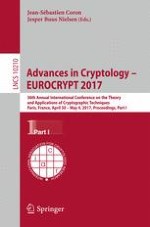2017 | OriginalPaper | Buchkapitel
Simplifying Design and Analysis of Complex Predicate Encryption Schemes
verfasst von : Shashank Agrawal, Melissa Chase
Erschienen in: Advances in Cryptology – EUROCRYPT 2017
Aktivieren Sie unsere intelligente Suche, um passende Fachinhalte oder Patente zu finden.
Wählen Sie Textabschnitte aus um mit Künstlicher Intelligenz passenden Patente zu finden. powered by
Markieren Sie Textabschnitte, um KI-gestützt weitere passende Inhalte zu finden. powered by
